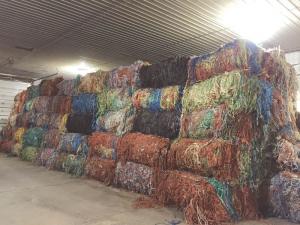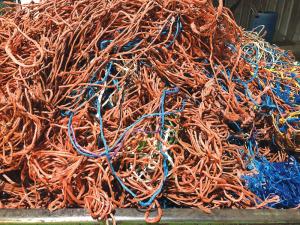2020 - Volume #44, Issue #3, Page #02
[ Sample Stories From This Issue | List of All Stories In This Issue | Print this story
| Read this issue]
How To Get Paid For Used Poly Twine
 |
 |
 |
“Synthetic twine can be reprocessed and used in other products,” says Van Kampen, I-90 Reprocessing. “We pelletize more than 100,000 lbs. of used twine per week. A lot of it goes into car parts, like the inside of bumpers and such.”
Van Kampen and a co-worker got started reprocessing twine for a former employer who made twine. They proposed using reprocessed twine in the twine-making process.
“We were making twine that was about 30 percent recycled poly from used twine,” recalls Van Kampen.
When the company was sold, Van Kampen purchased the equipment and set up his own company. Today he has 12 employees and a 30,000-sq. ft. facility.
For synthetic twine to be reprocessed, it has to be kept separate from sisal twine, netting, and other materials, including ag plastic. What makes it valuable for reprocessing is that synthetic twine is a single type of polypropylene.
“There are as many as 1,000 different types of polypropylene being used,” says Van Kampen. “We go after just one kind - synthetic twine. Plastic netting is a polyethylene. We can’t use it.”
Once the twine arrives, it is chopped up, washed, dried and pelletized. If contaminated, it has to be picked over. If there is too much non-synthetic twine, it is sent to the landfill.
To retain its value, Van Kampen suggests saving the twine as it is removed from the bale. It should be set aside in a container or at least stored off the ground.
I-90 is currently paying about 8¢ per lb. or more, depending on the distance hauled. Most of the twine Van Kampen receives is gathered within 500 miles of his plant.
“Most people bring it in by the semi load, 40,000 lbs. at a crack,” says Van Kampen. “We want more. We often run out of pellets because we can’t get enough twine.”
He notes that there are a hundred million pounds of twine used every year, and only 5 to 10 percent of it is collected and reprocessed. “There is a great opportunity for people to make money and help reduce waste,” says Van Kampen. “We are looking for people to collect twine in their area and bring it to us. We are always looking for a steady source of used twine. Our goal is to do 5 to 6 million lbs. per year.”
Contact: FARM SHOW Followup, I-90 Reprocessing Inc., 24104 755th Ave., Albert Lea, Minn. 56007 (ph 507-391 4063).

Click here to download page story appeared in.

Click here to read entire issue
To read the rest of this story, download this issue below or click here to register with your account number.




